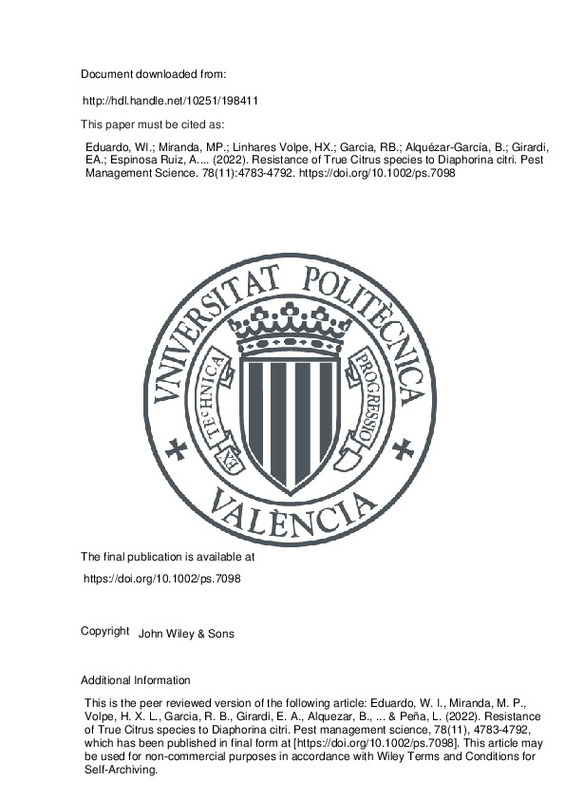JavaScript is disabled for your browser. Some features of this site may not work without it.
Buscar en RiuNet
Listar
Mi cuenta
Estadísticas
Ayuda RiuNet
Admin. UPV
Resistance of True Citrus species to Diaphorina citri
Mostrar el registro sencillo del ítem
Ficheros en el ítem
| dc.contributor.author | Eduardo, Wellington Ivo
|
es_ES |
| dc.contributor.author | Miranda, Marcelo Pedreira
|
es_ES |
| dc.contributor.author | Linhares Volpe, Haroldo Xavier
|
es_ES |
| dc.contributor.author | Garcia, Rafael Brandao
|
es_ES |
| dc.contributor.author | Alquézar-García, Berta
|
es_ES |
| dc.contributor.author | Girardi, Eduardo Augusto
|
es_ES |
| dc.contributor.author | Espinosa Ruiz, Ana
|
es_ES |
| dc.contributor.author | Peña, Leandro
|
es_ES |
| dc.date.accessioned | 2023-10-19T18:01:34Z | |
| dc.date.available | 2023-10-19T18:01:34Z | |
| dc.date.issued | 2022-11 | es_ES |
| dc.identifier.issn | 1526-498X | es_ES |
| dc.identifier.uri | http://hdl.handle.net/10251/198411 | |
| dc.description | This is the peer reviewed version of the following article: Eduardo, W. I., Miranda, M. P., Volpe, H. X. L., Garcia, R. B., Girardi, E. A., Alquezar, B., ... & Peña, L. (2022). Resistance of True Citrus species to Diaphorina citri. Pest management science, 78(11), 4783-4792, which has been published in final form at [https://doi.org/10.1002/ps.7098]. This article may be used for non-commercial purposes in accordance with Wiley Terms and Conditions for Self-Archiving. | es_ES |
| dc.description.abstract | [EN] BACKGROUND Host genetic resistance is a promising strategy for the management of Diaphorina citri Kuwayama (Hemiptera: Psyllidae), and consequently Huanglongbing (HLB). To date, no study has investigated the resistance to D. citri in the clonal and vegetatively propagated plants of the Microcitrus, Eremocitrus, and Atalantia genera. This study assesses Near and True Citrus genotype antixenosis and antibiosis against D. citri, with trichome density and volatile emission as possible mechanisms of resistance. RESULTS All genotypes were oviposited by D. citri, however, 8 of 14 genotypes were less oviposited than Citrus x sinensis 'Valencia' (susceptible control). Diaphorina citri nymphs had lower nymphal viability in E. glauca (31%) and M. warburgiana (58%) than that in Citrus x sinensis (77%). The behavioral assay showed that 30% of D. citri nymphs in the last instars evaded E. glauca shoots, whereas no nymphs evaded Citrus x sinensis shoots. A higher trichome density was observed in E. glauca shoots compared to the other genotypes. Chemical analysis revealed differences in the volatile profiles of E. glauca and Citrus x sinensis. CONCLUSION Eremocitrus glauca and M. warburgiana genotypes were more resistant to D. citri than Citrus x sinensis. Higher trichome density in the shoots may negatively influence the development of D. citri nymphs. Eremocitrus glauca volatiles may also be involved in their resistance to D. citri. | es_ES |
| dc.description.sponsorship | This work was funded by the Fund for Citrus Protection (Fundecitrus), the European Union H2020 Innovation Action Program (grant #817526), and the project PID2019-104569RB-I00 from AEI-Spain. WIE received a postdoctoral fellowship (Proc. 2019/19649-3) from SAo Paulo Research Foundation (FAPESP). MPM received a research fellowship (Proc. 301805/2018-0) from Council for Scientific and Technological Development (CNPq), Brazil. The authors thank the Metabolomic service from Instituto de Biologia Molecular y Celular de Plantas, CSIC/UPV (IBMCP), Valencia, Spain for their help with the volatile emission analysis. The authors also acknowledge Fundecitrus and EMBRAPA Cassava & Fruits for providing plant materials. | es_ES |
| dc.language | Inglés | es_ES |
| dc.publisher | John Wiley & Sons | es_ES |
| dc.relation.ispartof | Pest Management Science | es_ES |
| dc.rights | Reserva de todos los derechos | es_ES |
| dc.subject | Host plant resistance | es_ES |
| dc.subject | Oceanian citrus species | es_ES |
| dc.subject | Asian citrus psyllid | es_ES |
| dc.subject | Trichomes | es_ES |
| dc.subject | Huanglongbing | es_ES |
| dc.subject | Volatiles | es_ES |
| dc.subject.classification | BIOQUIMICA Y BIOLOGIA MOLECULAR | es_ES |
| dc.title | Resistance of True Citrus species to Diaphorina citri | es_ES |
| dc.type | Artículo | es_ES |
| dc.identifier.doi | 10.1002/ps.7098 | es_ES |
| dc.relation.projectID | info:eu-repo/grantAgreement/AEI/Plan Estatal de Investigación Científica y Técnica y de Innovación 2017-2020/PID2019-104569RB-I00/ES/MEJORA GENETICA DE PORTAINJERTOS CITRICOS PARA GENERAR RESISTENCIA A VIEJAS Y NUEVAS ENFERMEDADES EMERGENTES/ | es_ES |
| dc.relation.projectID | info:eu-repo/grantAgreement/CNPq//301805%2F2018-0/ | es_ES |
| dc.relation.projectID | info:eu-repo/grantAgreement/EC/H2020/817526/EU | es_ES |
| dc.relation.projectID | info:eu-repo/grantAgreement/FAPESP//2019%2F19649-3/ | es_ES |
| dc.rights.accessRights | Abierto | es_ES |
| dc.contributor.affiliation | Universitat Politècnica de València. Instituto Universitario Mixto de Biología Molecular y Celular de Plantas - Institut Universitari Mixt de Biologia Molecular i Cel·lular de Plantes | es_ES |
| dc.description.bibliographicCitation | Eduardo, WI.; Miranda, MP.; Linhares Volpe, HX.; Garcia, RB.; Alquézar-García, B.; Girardi, EA.; Espinosa Ruiz, A.... (2022). Resistance of True Citrus species to Diaphorina citri. Pest Management Science. 78(11):4783-4792. https://doi.org/10.1002/ps.7098 | es_ES |
| dc.description.accrualMethod | S | es_ES |
| dc.relation.publisherversion | https://doi.org/10.1002/ps.7098 | es_ES |
| dc.description.upvformatpinicio | 4783 | es_ES |
| dc.description.upvformatpfin | 4792 | es_ES |
| dc.type.version | info:eu-repo/semantics/publishedVersion | es_ES |
| dc.description.volume | 78 | es_ES |
| dc.description.issue | 11 | es_ES |
| dc.identifier.pmid | 35900363 | es_ES |
| dc.relation.pasarela | S\486986 | es_ES |
| dc.contributor.funder | European Commission | es_ES |
| dc.contributor.funder | Agencia Estatal de Investigación | es_ES |
| dc.contributor.funder | Universitat Politècnica de València | es_ES |
| dc.contributor.funder | Fundação de Amparo à Pesquisa do Estado de São Paulo | es_ES |
| dc.contributor.funder | Conselho Nacional de Desenvolvimento Científico e Tecnológico, Brasil | es_ES |







![[Cerrado]](/themes/UPV/images/candado.png)

